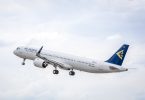In a sign of hard times for the travel industry, Stewart International Airport north of New York City has put itself on sale.
As the fall travel season begins, U.S. airlines are sharply reducing domestic flights and routes nationwide to cut their losses from high jet fuel prices. In one of the most dramatic examples, Stewart by November will lose 63% of the passenger air service it had last November, current airline schedules show. So for the next six months, Stewart’s owner, the Port Authority of New York and New Jersey, is waiving all fees it charges airlines to use that airport in hopes of keeping airlines it still has and luring new ones.
The drastic action by Stewart, and by other airports nationwide, is only one example of the widespread fallout of the airlines’ service cutbacks. The carriers’ misery is spreading, or is expected to spread, to virtually every industry they touch in the travel economy: hotels, rental cars, convention centers, websites that book travel, airports and others.
Labor Day drop-off
The Air Transport Association trade group forecast that travel over Labor Day weekend would be down about 6%, the first year-over-year drop in Labor Day passengers since 2002, following the 2001 terrorist attacks the previous fall.
“It’s a sharp reversal,” says ATA chief economist John Heimlich. “I think it’s an indication of what looms the rest of the year.”
This month, domestic airline capacity measured by the number of seats on flights will shrink 7% from last September, according to OAG-Official Airline Guide. As airlines continue to shrink, domestic capacity by November will be down 10% nationwide — forcing up airfares. In many markets, service cuts will be much deeper.
Travelocity.com reports that the average domestic round-trip airfare booked so far on its site for flights from Nov. 1 through Feb. 28, 2009, is up nearly 16% year-over-year. Travelocity says the average booked fare this winter is up 27% to New York’s three major airports, up 25% to Dallas/Fort Worth, up 22% to Atlanta, up 21% to Chicago and up 30% to Boston.
“These are the highest year-over-year airfare increases I’ve ever seen,” says Travelocity editor at large Amy Ziff.
For travel industry executives, the implications of less air service at higher prices are grim.
“You can see this spilling over into the whole travel business,” says Choice Hotels CEO Steve Joyce, whose company owns 10 hotel chains, including Comfort Inn and Econo Lodge. “We are getting hit.”
At a recent conference, Marriott International CEO J.W. Marriott Jr. reported softening in both business and leisure travel. Marriott said companies are reducing business travel and that last-minute group bookings are slowing.
But the good news for travelers is that many hotels are responding by discounting nightly rates and throwing in other incentives such as free gas.
Widespread hotel discounting is front and center at travel websites including Expedia.com, the world’s largest travel-booking site, which is promoting a hotel sale on its home page. For the first time on Expedia this year, hotels are offering discounts up to 50% off normal rates. More than 400 hotels in 23 cities are participating — double last year’s number.
“We’re seeing really good hotel deals in Hawaii, Las Vegas, Orlando and the Caribbean,” says Paul Brown, president of Expedia North America.
He notes that hotels likely to suffer most as a result of reductions in air service are those totally dependent on flights for visitors — destinations such as the Hawaiian Islands, the Bahamas, and Puerto Rico and other islands in the Caribbean.
But several top leisure and convention destinations in the Lower 48 states, such as Las Vegas, are also hurt by air-service cuts because they depend so heavily on visitors flying in. Because Las Vegas passengers are more likely to be leisure travelers paying low fares than are, say, passengers to Chicago, airlines have aggressively cut service to those types of destinations.
By November, Las Vegas McCarran Airport, the USA’s seventh busiest, will have nearly 16% fewer airline seats on departing flights than a year earlier, OAG schedule figures show.
During the first six months of this year in Las Vegas, the number of meetings in area hotels dropped 2%, according to the Convention and Visitors Authority. Hotel room occupancy rates during the first half fell slightly, and revenue from Las Vegas’ casinos dropped 5%.
Officials are bracing for worse results this fall. “We’re hearing from local hotels that some corporate meetings are being shortened, delayed or canceled,” says Kevin Bagger, the authority’s research director. That’s alarming because meetings of fewer than 500 people account for 50% of the region’s meeting attendance. Large conventions that run in the thousands account for 25%.
Airports hurt
On the front line of the airline industry’s woes are the airports, whose budgets depend in large part on fees that airlines pay for use of the facilities. The Airports Council International, their trade group, says at least a dozen U.S. airports are cutting fees or offering airlines other incentives to stay or to start service. They include Baton Rouge; Columbus and Dayton, Ohio; Mobile, Ala.; Minneapolis; Norfolk, Va.; Sacramento; San Jose; and Tampa.
“It’s a lot easier to keep an airline you have than attract new ones,” says New York Port Authority spokesman Pasquale DiFulco.






















